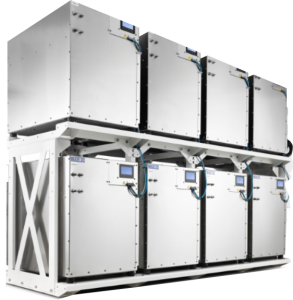Stay fresh… And keep viruses at bay
Has fresh air – genuinely fresh air – ever been more important? Certainly not on a superyacht, where people spend long periods together in relatively confined spaces.
We all saw what happened to cruise vessels when COVID-19 first imposed on our lives and health. The pandemic has made crystal clear how important it is not to recirculate air within a vessel.
Below we will explain how you can optimise the air security of your yacht and what that requires in practice. In a nutshell, however, the key benefits that a MAR-IX system offers you are
- We only use 100% fresh-air from outside
- Extracted air is never mixed with fresh air
Why is it different?
Worryingly, the majority of superyachts are currently equipped with installations that mix extraction air with fresh air in order to recover heat from the exhaust air. Mixing air sources in this way has the potential to spread viruses around the yacht via the ventilation system. It’s a continuous process and viruses cannot be entirely stopped by filters or UV-light solutions.
The heat recovery on every MAR-IX system uses a fluid process, with thermal energy in the extraction air captured and dirty air immediately discharged overboard. Moreover, each ventilated area of the yacht is isolated from the rest in our system: fresh air is supplied to all accommodation areas, extracted from the bathrooms and directly blown outside.
A MAR-IX system ensures there is no chance of any cross-contamination of supply and extraction air. Or anything more sinister.
Fresh air rules
Laid down and specified in ISO rules, the requirement for fresh air revolves around your comfort and health. You need to have the right levels of oxygen supplied to living areas. Stagnant air makes for an unpleasant living environment and your system will remove polluted air and odours. It also extracts moisture from bathrooms to reduce the chance of mould. Without proper ventilation on board you have a very unhealthy situation… So now the trick is to get that system right.
Tech talk
A fresh air system consists of a supply unit taking fresh air to connected areas and an extraction unit discharging air outside.
- A fresh air make-up supply unit (FAM) filters the incoming air through a coarse filter and F9 polyester fine filter
- Intake air is conditioned (preheated or cooled) and dehumidified before being supplied to the accommodations
- The fresh air will be supplied at room temperature
- Extraction is by fan or a system equipped with a return air make-up unit with heat recovery. Energy from the extracted air is re-supplied to the fresh air supply unit
- Recovered waste heat pre-cools incoming air in warm climates and pre-heats it in colder areas
- Liquid is used to transport the energy, with the extraction and supply units connected by a pipe and located separately from each other.
Dehumidification
Climatising fresh air requires dehumidification of the incoming air. In addition to cooling the air, the fresh air unit also reheats the air to achieve a lower relative humidity. While this can be done using electric heaters in the unit, a more sustainable way is via residual (recovered waste) heat. As reheating requires a considerable amount of energy 24/7, the use of residual heat for reheating offers serious savings on your e-load. With high demands for dehumidification the cooling capacity might increase to 20 Watt per m³ in the above scenario: A MAR-IX heat recovery solution will reduce this demand by approx. 10 Watt.
Under pressure
Our fresh air make-up units are fitted with a pressure-controlled fan that achieves a set pressure and keeps it stable. For example, set the pressure to 250 Pa and the fan speeds up until this level is reached. Open an air valve in the system and the pressure will drop: the fan then again increases the pressure until the desired setting is reached. The lower the set pressure, the lower the noise and energy consumption.
As pressure is measured over the fresh air unit itself, the fan will also compensate for contamination of the filters and guarantee the right amount of air. Should the fan no longer be able to reach the pressure, the FAM will display a message on its display and the main computer will indicate the need to replace a filter.


